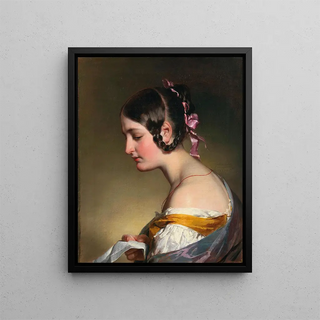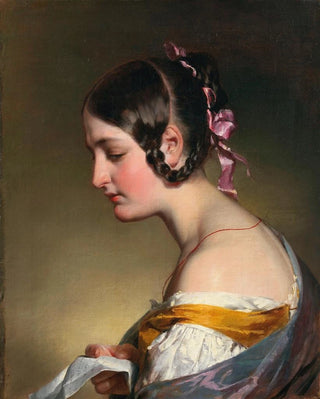Art print | The Letter - Friedrich von Amerling


View from behind

Frame (optional)
In the rich and complex universe of 19th-century art, "The Letter" by Friedrich von Amerling stands out as an iconic work, captivating the eye and the imagination. This painting, which depicts an intimate scene, immerses us in a moment of life filled with delicacy and poetry. The woman portrayed, absorbed in her reading, appears suspended in time, surrounded by a subdued atmosphere that invites contemplation. Amerling, master of the portrait, succeeds in capturing not only the physical appearance of his model but also the emotion emanating from this silent interaction with a letter. The soft light bathing the scene and the meticulous details of the textiles add an extra dimension to this work, transforming it into a true narrative painting.
Style and uniqueness of the work
Friedrich von Amerling's style is distinguished by its striking realism and its ability to breathe palpable life into its subjects. In "The Letter," every element is carefully considered, from the reflections of light on the woman's skin to the delicate folds of her dress. The artist uses a palette of soft colors, favoring pastel tones that evoke an atmosphere of serenity and intimacy. The composition is balanced, guiding the viewer's gaze toward the woman's face, whose pensive expression sparks a multitude of interpretations. Amerling, a true virtuoso, manages to marry technique and emotion, making this work not only aesthetically pleasing but also profoundly human. The subtlety of details, such as delicate accessories and decorative elements, enriches the visual narration, making "The Letter" a centerpiece of Romantic art.
The artist and his influence
Friedrich von Amerling, born in 1803 in Vienna, is one of the most renowned portraitists of his time. Trained in the ateliers of great masters, he developed a unique style that combines tradition and innovation. Amerling had a considerable influence on his contemporaries, notably through his ability to capture the psychology of his models through portraiture. His works, often imbued with a certain melancholy, reflect the concerns of a society in transition, where the search for individual identity takes a central role.

Matte finish

View from behind

Frame (optional)
In the rich and complex universe of 19th-century art, "The Letter" by Friedrich von Amerling stands out as an iconic work, captivating the eye and the imagination. This painting, which depicts an intimate scene, immerses us in a moment of life filled with delicacy and poetry. The woman portrayed, absorbed in her reading, appears suspended in time, surrounded by a subdued atmosphere that invites contemplation. Amerling, master of the portrait, succeeds in capturing not only the physical appearance of his model but also the emotion emanating from this silent interaction with a letter. The soft light bathing the scene and the meticulous details of the textiles add an extra dimension to this work, transforming it into a true narrative painting.
Style and uniqueness of the work
Friedrich von Amerling's style is distinguished by its striking realism and its ability to breathe palpable life into its subjects. In "The Letter," every element is carefully considered, from the reflections of light on the woman's skin to the delicate folds of her dress. The artist uses a palette of soft colors, favoring pastel tones that evoke an atmosphere of serenity and intimacy. The composition is balanced, guiding the viewer's gaze toward the woman's face, whose pensive expression sparks a multitude of interpretations. Amerling, a true virtuoso, manages to marry technique and emotion, making this work not only aesthetically pleasing but also profoundly human. The subtlety of details, such as delicate accessories and decorative elements, enriches the visual narration, making "The Letter" a centerpiece of Romantic art.
The artist and his influence
Friedrich von Amerling, born in 1803 in Vienna, is one of the most renowned portraitists of his time. Trained in the ateliers of great masters, he developed a unique style that combines tradition and innovation. Amerling had a considerable influence on his contemporaries, notably through his ability to capture the psychology of his models through portraiture. His works, often imbued with a certain melancholy, reflect the concerns of a society in transition, where the search for individual identity takes a central role.






